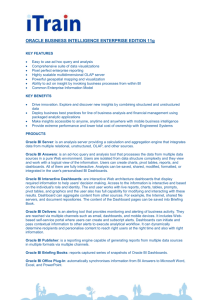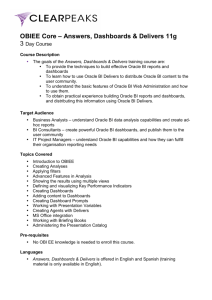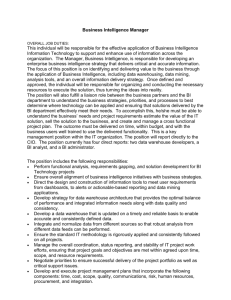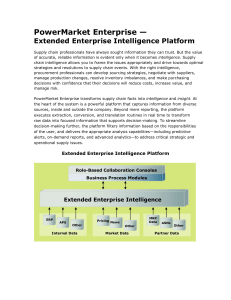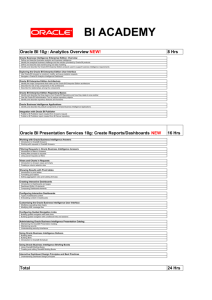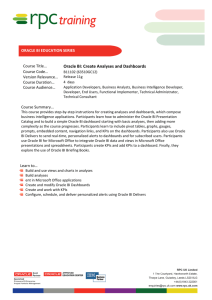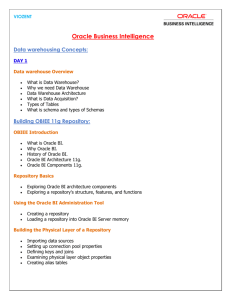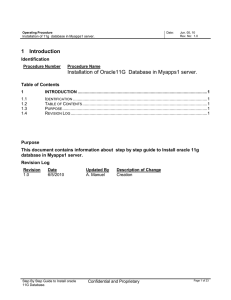Other Courses Offered
advertisement
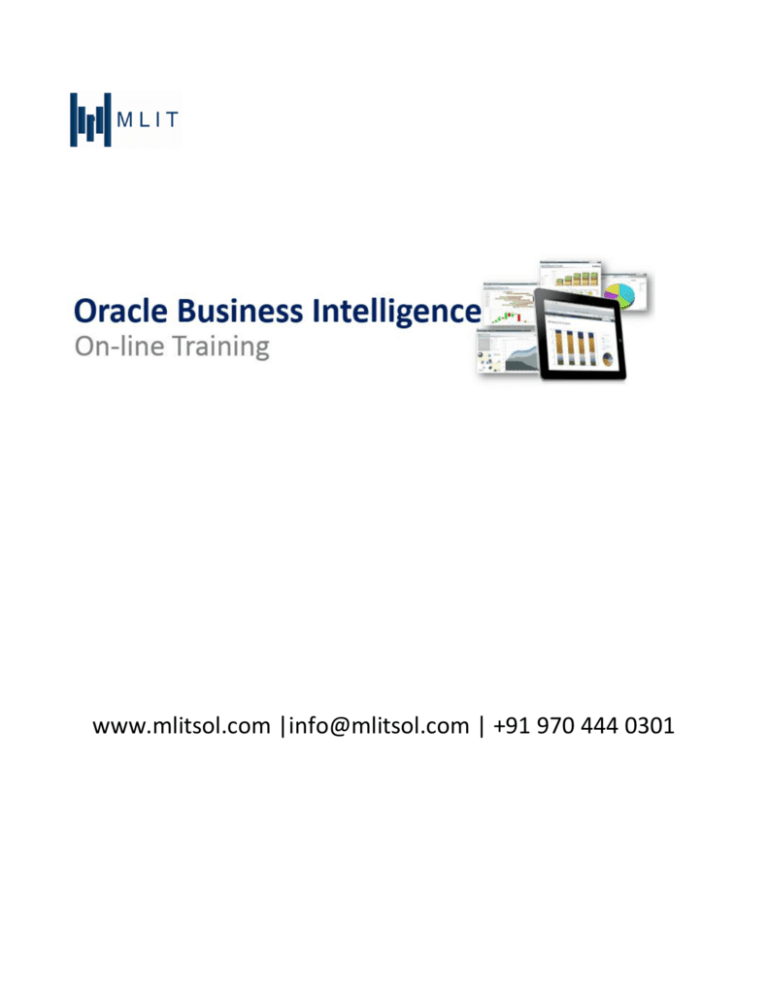
www.mlitsol.com |info@mlitsol.com | +91 970 444 0301 Oracle Business Intelligence Enterprise Edition 11g Course Overview This Course covers installation to deploying reports and dashboards, this course starts by covering architecture, creating repositories using data from relational and file sources, catalogs and deployment. It then takes delegates through building analyses and dashboards. New features such as the Action Framework are covered in detail, together with areas such as security, deployment between environments, and performing systems management tasks using Enterprise Manager and the WLST scripting environment. Also provide assignments for end of each topics. Contents 1. INTRODUCTION 1.1 Basic understanding of Data Warehouse concepts. 1.2 Overview of OBIEE, and New Features in 11g 1.3 Product Demonstration 1.4 Business Intelligence Background 1.5 The Common Information Model 1.6 Installation of OBIEE 11.1.1.7.X 1.7 Architectural Overview 1.8 Repository Overview Repository (RPD) 2. PHYSICAL LAYER 2.1 Physical Layer Overview 2.2 Database Connectivity 2.3 Importing Metadata 2.4 Browsing the Physical Layer 2.5 Aliases &Joins 2.6 Exercise 1 - Create the Physical layer 3. BUSINESS MODEL AND MAPPING LAYER 3.1 Business Model and Mapping Layer Over View 3.2 Creating New Business model 3.3 Renaming 3.4 Aggregation 3.5 Exercise 2 - Create Business Model and Mapping Layer 4. PRESENTATION LAYER 4.1 Presentation Layer Overview 4.2 New Subject Area 4.3 Exercise 3 - Create the Presentation Layer 2 | Page www.mlitsol.com |info@mlitsol.com | +91 970 444 0301 Oracle Business Intelligence Enterprise Edition 11g 5. DEPLOYING 5.1 Deploying Overview 5.2 Uploading the Repository (RPD) 5.3 Using the Online Repository 6. LOGICAL TABLES AND COLUMNS 6.1 Logical table overview 6.2 Logical columns overview 6.3 Using the Presentation Layer 6.4 Exercise 4 - Creating Logical Table and Columns 7. HIERARCHIES 7.1 Hierarchies overview 7.2 Creating a Logical Dimension 7.3 Logical Levels and Presentation hierarchies 7.4 Ragged and Parent-Child Hierarchies Overview 7.5 Using the Presentation Layer 7.6 Exercise 6 - Create Ragged and Parent-Child Hierarchies 8. USING AGGREGATES 8.1 Aggregates overview 8.2 Modelling aggregate tables 8.3 Exercise 7 - Using the Aggregate Persistence Wizard 9. REPOSITORY VARIABLES 9.1 Repository and Session variables 9.2 Initialization blocks 9.3 Using the Variable Manager 10. COMPLEX MEASURES 10.1 Complex Measures 10.2 Using the Presentation Layer 10.3 Exercise 7 - Complex Measures 11. CACHE MANAGEMENT 11.1 Using Cache Manager 11.2 Inspecting cache reports 11.3 Purging cache entries Analytics 12. WORKING WITH ANALYTICS 12.1 Accessing Oracle BI 3 | Page www.mlitsol.com |info@mlitsol.com | +91 970 444 0301 Oracle Business Intelligence Enterprise Edition 11g 12.2 12.3 12.4 12.5 12.6 12.7 Creating a new analysis Column properties Viewing the results Saving to the Catalog Table views Exercise 1: A simple analysis 13. FILTERING REQUEST 13.1 Introduction to filters in Answers 13.2 Adding filter prompts to requests 13.3 Using saved requests as filters 14. GRAPHS AND INTERACTION 14.1 Working with Graphs 14.2 Graph properties 14.3 Exercise 3: Graphs 14.4 Interaction – Master detail linking 14.5 Exercise 4: Master detail linking 15. SELECTION STEPS 15.1 Selection steps Overview 15.2 Exercise 6: Selection steps 16. MORE VIEWS 16.1 Working with Gauges & View selectors 16.2 Exercise 7: Gauges and view selectors 16.3 Interaction – Action links 16.4 Exercise 8: Action links 17. DASHBOARDS 17.1 Types of Dashboard content 17.2 Embedding content in Dashboards 17.3 Dashboard properties 17.4 Exercise 9: Dashboards 17.5 Dashboard prompts 17.6 Links and images 17.7 Exercise 10: Prompts and agents 18. DELIVERS 18.1 Introduction to OracleBI Scheduler 18.2 Building Agents 4 | Page www.mlitsol.com |info@mlitsol.com | +91 970 444 0301 Oracle Business Intelligence Enterprise Edition 11g 19. SECURITY 19.1 Creating users and groups 19.2 Setting permissions for users and groups 19.3 Authenticating using a external table 19.4 Setting query limits and timing restrictions 19.5 Setting filters to personalize information 20. DIRECT DATABASE REQUEST 20.1 Enabling Execute Direct Database Requests 20.2 Granting Edit/ Execute Direct Database Analysis permissions 20.3 Verify Permissions to user/role 20.4 Creating Direct Database Request 21. KPIs and KPI WATCHLIST 21.1 Overview of KPIs 21.2 Overview of KPI Watch lists 21.3 Creating KPIs and KPI Watch lists 22. SCORECARDS 22.1 Overview of Scorecards 22.2 Creating Scorecards 22.3 Adding KPIs to the Scorecards Other Courses Offered: Oracle Business Intelligence Applications – 7.9.6.x & 11g Oracle BI Mobile App Developer Informatica Oracle Data Integrator 5 | Page www.mlitsol.com |info@mlitsol.com | +91 970 444 0301
